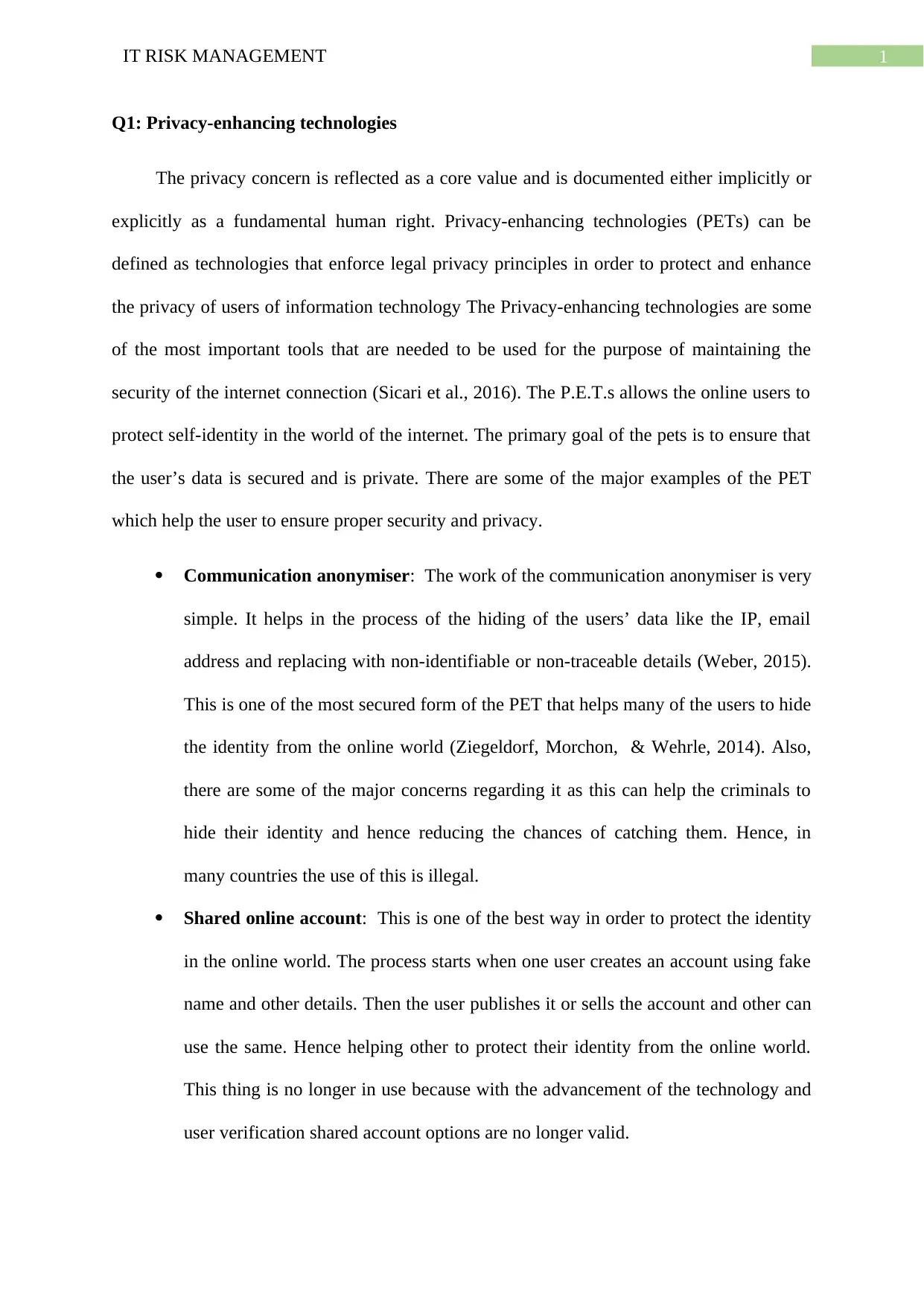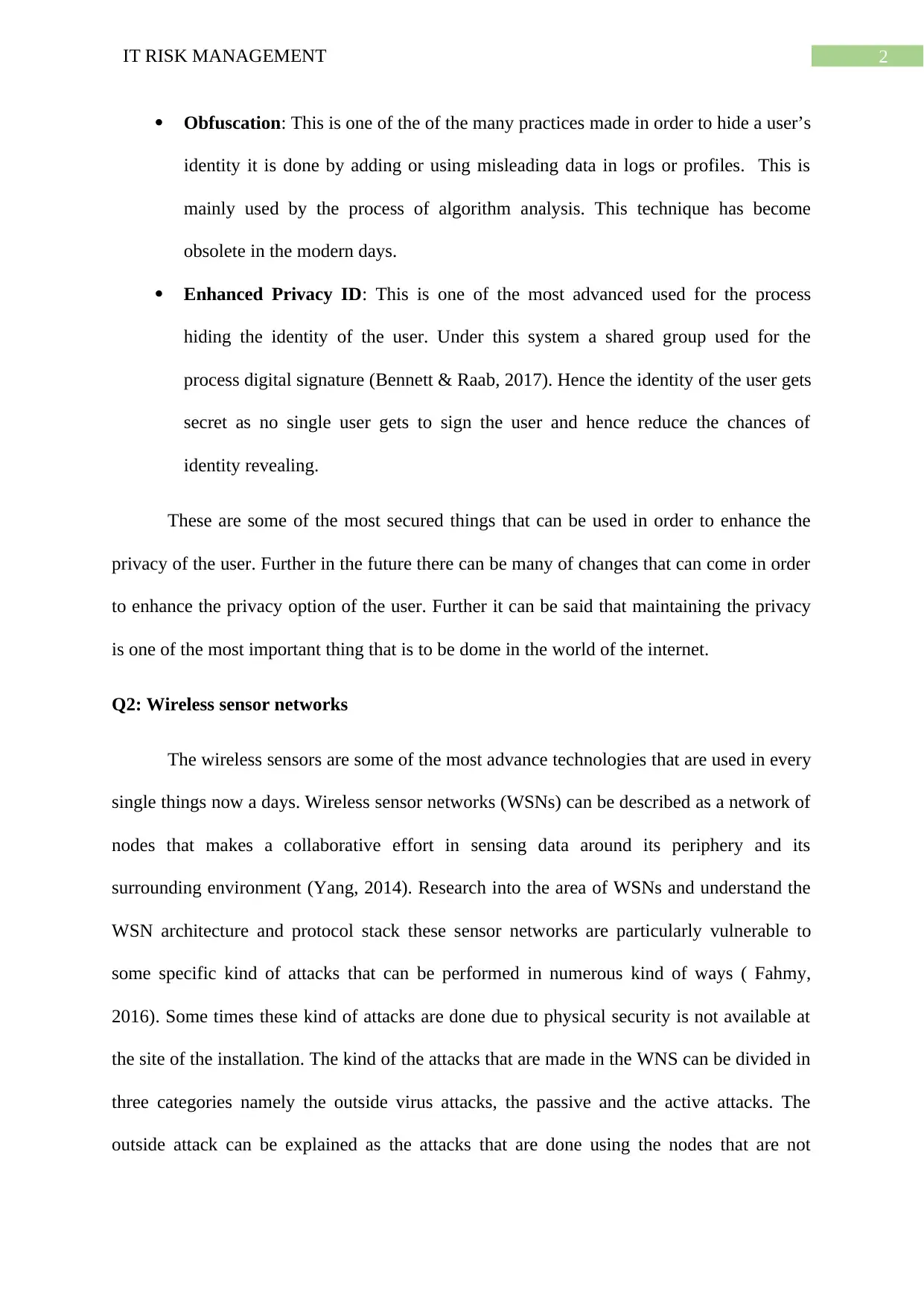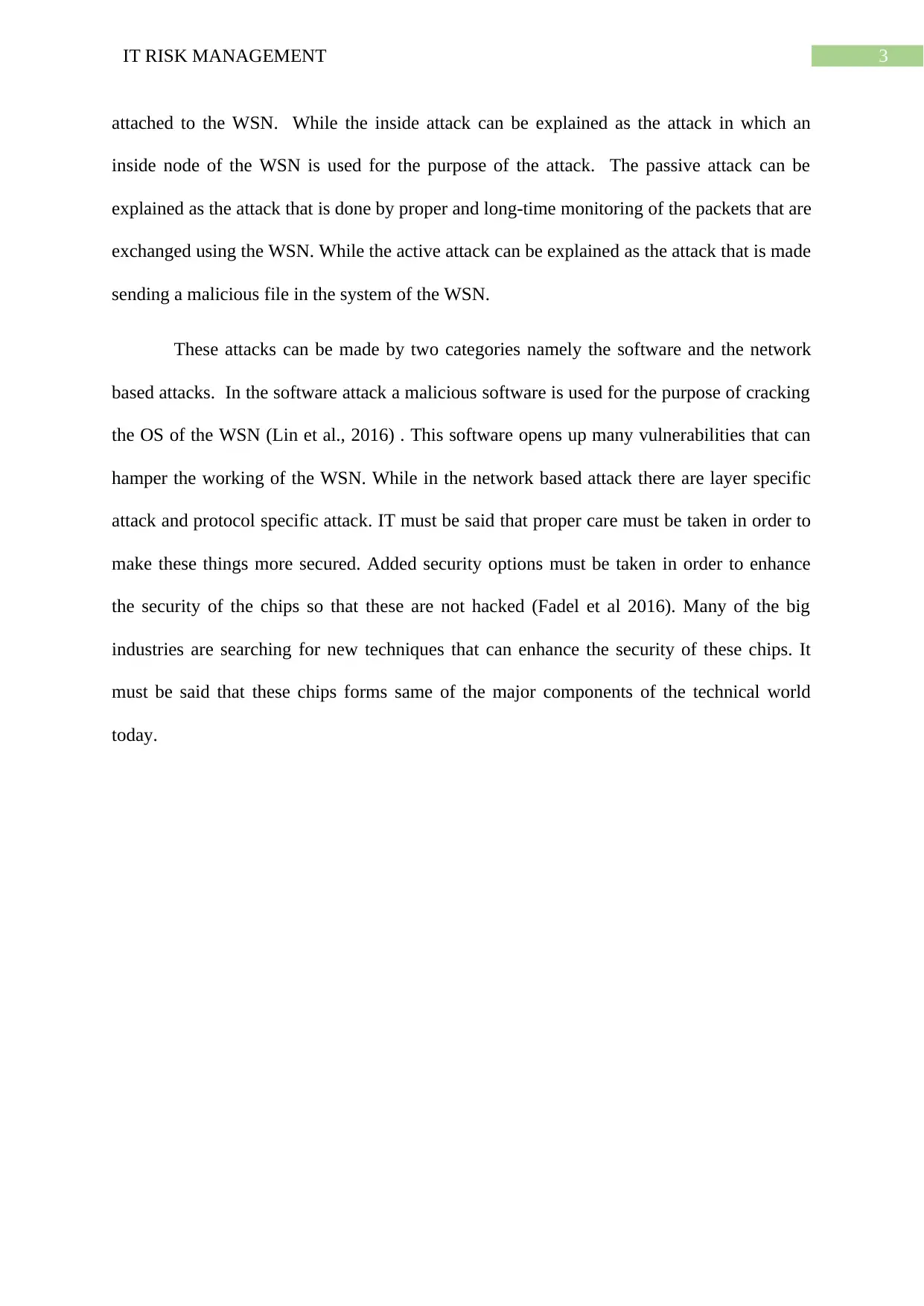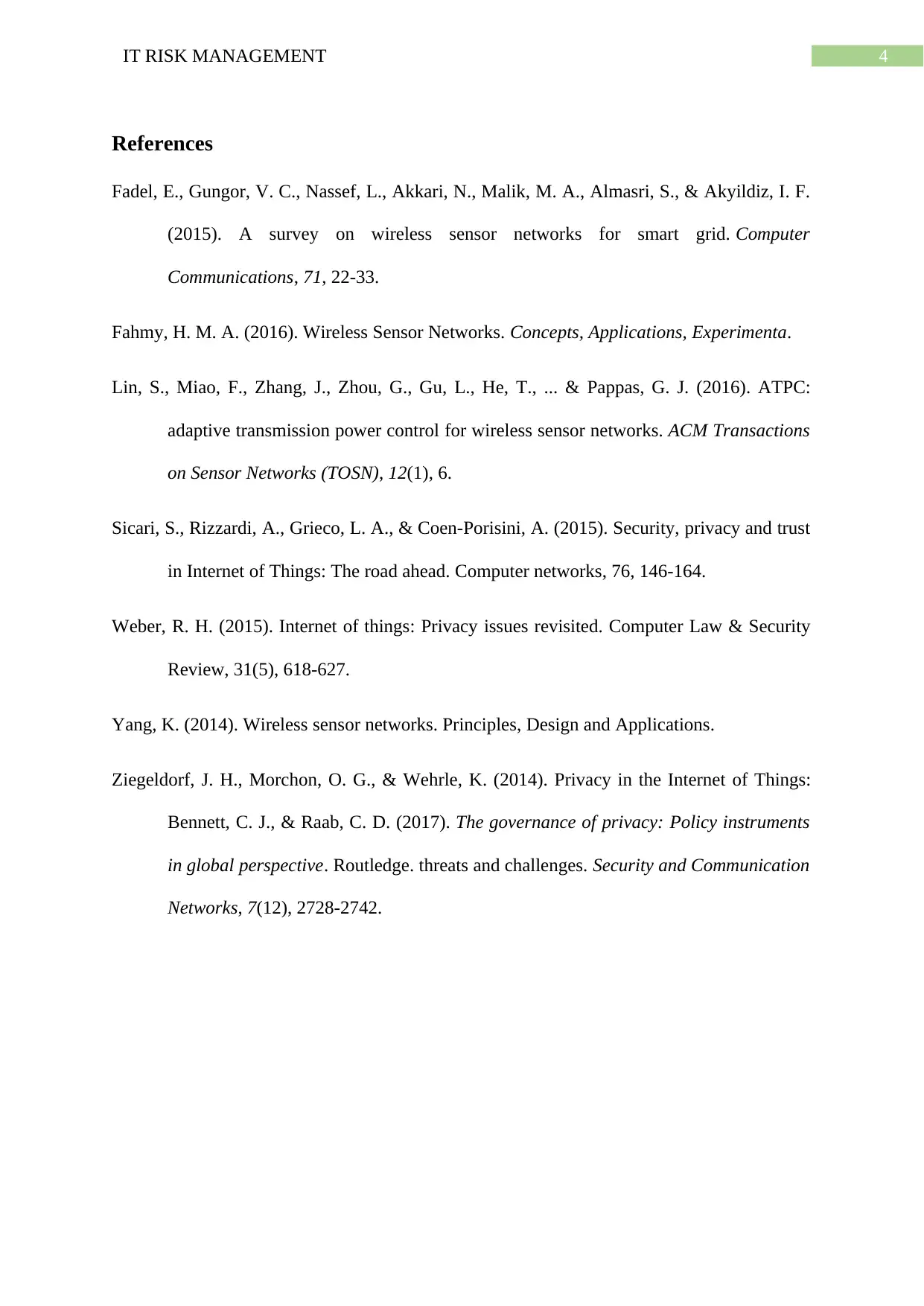Evaluating Privacy Technologies and Wireless Sensor Network Security
VerifiedAdded on 2023/06/07
|5
|1305
|122
Report
AI Summary
This report provides an overview of IT risk management, focusing on privacy-enhancing technologies (PETs) and wireless sensor networks (WSNs). It explores various PETs like communication anonymizers, shared online accounts, obfuscation, and enhanced privacy IDs, discussing their functionalities and limitations in protecting user privacy. The report also delves into the architecture and protocol stack of WSNs, examining potential threats and vulnerabilities, including outside and inside attacks, passive and active attacks, and software and network-based attacks. Furthermore, it emphasizes the importance of implementing robust security measures to mitigate these risks and enhance the overall security of WSNs, highlighting ongoing research in developing advanced security techniques for these critical components of the modern technological landscape. Desklib offers a wealth of resources for students studying IT risk management and related topics, including past papers and solved assignments.

Running head: IT RISK MANAGEMENT
IT risk management
Name of the student
Name of the university
Author note
IT risk management
Name of the student
Name of the university
Author note
Paraphrase This Document
Need a fresh take? Get an instant paraphrase of this document with our AI Paraphraser

1IT RISK MANAGEMENT
Q1: Privacy-enhancing technologies
The privacy concern is reflected as a core value and is documented either implicitly or
explicitly as a fundamental human right. Privacy-enhancing technologies (PETs) can be
defined as technologies that enforce legal privacy principles in order to protect and enhance
the privacy of users of information technology The Privacy-enhancing technologies are some
of the most important tools that are needed to be used for the purpose of maintaining the
security of the internet connection (Sicari et al., 2016). The P.E.T.s allows the online users to
protect self-identity in the world of the internet. The primary goal of the pets is to ensure that
the user’s data is secured and is private. There are some of the major examples of the PET
which help the user to ensure proper security and privacy.
Communication anonymiser: The work of the communication anonymiser is very
simple. It helps in the process of the hiding of the users’ data like the IP, email
address and replacing with non-identifiable or non-traceable details (Weber, 2015).
This is one of the most secured form of the PET that helps many of the users to hide
the identity from the online world (Ziegeldorf, Morchon, & Wehrle, 2014). Also,
there are some of the major concerns regarding it as this can help the criminals to
hide their identity and hence reducing the chances of catching them. Hence, in
many countries the use of this is illegal.
Shared online account: This is one of the best way in order to protect the identity
in the online world. The process starts when one user creates an account using fake
name and other details. Then the user publishes it or sells the account and other can
use the same. Hence helping other to protect their identity from the online world.
This thing is no longer in use because with the advancement of the technology and
user verification shared account options are no longer valid.
Q1: Privacy-enhancing technologies
The privacy concern is reflected as a core value and is documented either implicitly or
explicitly as a fundamental human right. Privacy-enhancing technologies (PETs) can be
defined as technologies that enforce legal privacy principles in order to protect and enhance
the privacy of users of information technology The Privacy-enhancing technologies are some
of the most important tools that are needed to be used for the purpose of maintaining the
security of the internet connection (Sicari et al., 2016). The P.E.T.s allows the online users to
protect self-identity in the world of the internet. The primary goal of the pets is to ensure that
the user’s data is secured and is private. There are some of the major examples of the PET
which help the user to ensure proper security and privacy.
Communication anonymiser: The work of the communication anonymiser is very
simple. It helps in the process of the hiding of the users’ data like the IP, email
address and replacing with non-identifiable or non-traceable details (Weber, 2015).
This is one of the most secured form of the PET that helps many of the users to hide
the identity from the online world (Ziegeldorf, Morchon, & Wehrle, 2014). Also,
there are some of the major concerns regarding it as this can help the criminals to
hide their identity and hence reducing the chances of catching them. Hence, in
many countries the use of this is illegal.
Shared online account: This is one of the best way in order to protect the identity
in the online world. The process starts when one user creates an account using fake
name and other details. Then the user publishes it or sells the account and other can
use the same. Hence helping other to protect their identity from the online world.
This thing is no longer in use because with the advancement of the technology and
user verification shared account options are no longer valid.

2IT RISK MANAGEMENT
Obfuscation: This is one of the of the many practices made in order to hide a user’s
identity it is done by adding or using misleading data in logs or profiles. This is
mainly used by the process of algorithm analysis. This technique has become
obsolete in the modern days.
Enhanced Privacy ID: This is one of the most advanced used for the process
hiding the identity of the user. Under this system a shared group used for the
process digital signature (Bennett & Raab, 2017). Hence the identity of the user gets
secret as no single user gets to sign the user and hence reduce the chances of
identity revealing.
These are some of the most secured things that can be used in order to enhance the
privacy of the user. Further in the future there can be many of changes that can come in order
to enhance the privacy option of the user. Further it can be said that maintaining the privacy
is one of the most important thing that is to be dome in the world of the internet.
Q2: Wireless sensor networks
The wireless sensors are some of the most advance technologies that are used in every
single things now a days. Wireless sensor networks (WSNs) can be described as a network of
nodes that makes a collaborative effort in sensing data around its periphery and its
surrounding environment (Yang, 2014). Research into the area of WSNs and understand the
WSN architecture and protocol stack these sensor networks are particularly vulnerable to
some specific kind of attacks that can be performed in numerous kind of ways ( Fahmy,
2016). Some times these kind of attacks are done due to physical security is not available at
the site of the installation. The kind of the attacks that are made in the WNS can be divided in
three categories namely the outside virus attacks, the passive and the active attacks. The
outside attack can be explained as the attacks that are done using the nodes that are not
Obfuscation: This is one of the of the many practices made in order to hide a user’s
identity it is done by adding or using misleading data in logs or profiles. This is
mainly used by the process of algorithm analysis. This technique has become
obsolete in the modern days.
Enhanced Privacy ID: This is one of the most advanced used for the process
hiding the identity of the user. Under this system a shared group used for the
process digital signature (Bennett & Raab, 2017). Hence the identity of the user gets
secret as no single user gets to sign the user and hence reduce the chances of
identity revealing.
These are some of the most secured things that can be used in order to enhance the
privacy of the user. Further in the future there can be many of changes that can come in order
to enhance the privacy option of the user. Further it can be said that maintaining the privacy
is one of the most important thing that is to be dome in the world of the internet.
Q2: Wireless sensor networks
The wireless sensors are some of the most advance technologies that are used in every
single things now a days. Wireless sensor networks (WSNs) can be described as a network of
nodes that makes a collaborative effort in sensing data around its periphery and its
surrounding environment (Yang, 2014). Research into the area of WSNs and understand the
WSN architecture and protocol stack these sensor networks are particularly vulnerable to
some specific kind of attacks that can be performed in numerous kind of ways ( Fahmy,
2016). Some times these kind of attacks are done due to physical security is not available at
the site of the installation. The kind of the attacks that are made in the WNS can be divided in
three categories namely the outside virus attacks, the passive and the active attacks. The
outside attack can be explained as the attacks that are done using the nodes that are not
⊘ This is a preview!⊘
Do you want full access?
Subscribe today to unlock all pages.

Trusted by 1+ million students worldwide

3IT RISK MANAGEMENT
attached to the WSN. While the inside attack can be explained as the attack in which an
inside node of the WSN is used for the purpose of the attack. The passive attack can be
explained as the attack that is done by proper and long-time monitoring of the packets that are
exchanged using the WSN. While the active attack can be explained as the attack that is made
sending a malicious file in the system of the WSN.
These attacks can be made by two categories namely the software and the network
based attacks. In the software attack a malicious software is used for the purpose of cracking
the OS of the WSN (Lin et al., 2016) . This software opens up many vulnerabilities that can
hamper the working of the WSN. While in the network based attack there are layer specific
attack and protocol specific attack. IT must be said that proper care must be taken in order to
make these things more secured. Added security options must be taken in order to enhance
the security of the chips so that these are not hacked (Fadel et al 2016). Many of the big
industries are searching for new techniques that can enhance the security of these chips. It
must be said that these chips forms same of the major components of the technical world
today.
attached to the WSN. While the inside attack can be explained as the attack in which an
inside node of the WSN is used for the purpose of the attack. The passive attack can be
explained as the attack that is done by proper and long-time monitoring of the packets that are
exchanged using the WSN. While the active attack can be explained as the attack that is made
sending a malicious file in the system of the WSN.
These attacks can be made by two categories namely the software and the network
based attacks. In the software attack a malicious software is used for the purpose of cracking
the OS of the WSN (Lin et al., 2016) . This software opens up many vulnerabilities that can
hamper the working of the WSN. While in the network based attack there are layer specific
attack and protocol specific attack. IT must be said that proper care must be taken in order to
make these things more secured. Added security options must be taken in order to enhance
the security of the chips so that these are not hacked (Fadel et al 2016). Many of the big
industries are searching for new techniques that can enhance the security of these chips. It
must be said that these chips forms same of the major components of the technical world
today.
Paraphrase This Document
Need a fresh take? Get an instant paraphrase of this document with our AI Paraphraser

4IT RISK MANAGEMENT
References
Fadel, E., Gungor, V. C., Nassef, L., Akkari, N., Malik, M. A., Almasri, S., & Akyildiz, I. F.
(2015). A survey on wireless sensor networks for smart grid. Computer
Communications, 71, 22-33.
Fahmy, H. M. A. (2016). Wireless Sensor Networks. Concepts, Applications, Experimenta.
Lin, S., Miao, F., Zhang, J., Zhou, G., Gu, L., He, T., ... & Pappas, G. J. (2016). ATPC:
adaptive transmission power control for wireless sensor networks. ACM Transactions
on Sensor Networks (TOSN), 12(1), 6.
Sicari, S., Rizzardi, A., Grieco, L. A., & Coen-Porisini, A. (2015). Security, privacy and trust
in Internet of Things: The road ahead. Computer networks, 76, 146-164.
Weber, R. H. (2015). Internet of things: Privacy issues revisited. Computer Law & Security
Review, 31(5), 618-627.
Yang, K. (2014). Wireless sensor networks. Principles, Design and Applications.
Ziegeldorf, J. H., Morchon, O. G., & Wehrle, K. (2014). Privacy in the Internet of Things:
Bennett, C. J., & Raab, C. D. (2017). The governance of privacy: Policy instruments
in global perspective. Routledge. threats and challenges. Security and Communication
Networks, 7(12), 2728-2742.
References
Fadel, E., Gungor, V. C., Nassef, L., Akkari, N., Malik, M. A., Almasri, S., & Akyildiz, I. F.
(2015). A survey on wireless sensor networks for smart grid. Computer
Communications, 71, 22-33.
Fahmy, H. M. A. (2016). Wireless Sensor Networks. Concepts, Applications, Experimenta.
Lin, S., Miao, F., Zhang, J., Zhou, G., Gu, L., He, T., ... & Pappas, G. J. (2016). ATPC:
adaptive transmission power control for wireless sensor networks. ACM Transactions
on Sensor Networks (TOSN), 12(1), 6.
Sicari, S., Rizzardi, A., Grieco, L. A., & Coen-Porisini, A. (2015). Security, privacy and trust
in Internet of Things: The road ahead. Computer networks, 76, 146-164.
Weber, R. H. (2015). Internet of things: Privacy issues revisited. Computer Law & Security
Review, 31(5), 618-627.
Yang, K. (2014). Wireless sensor networks. Principles, Design and Applications.
Ziegeldorf, J. H., Morchon, O. G., & Wehrle, K. (2014). Privacy in the Internet of Things:
Bennett, C. J., & Raab, C. D. (2017). The governance of privacy: Policy instruments
in global perspective. Routledge. threats and challenges. Security and Communication
Networks, 7(12), 2728-2742.
1 out of 5
Related Documents
Your All-in-One AI-Powered Toolkit for Academic Success.
+13062052269
info@desklib.com
Available 24*7 on WhatsApp / Email
![[object Object]](/_next/static/media/star-bottom.7253800d.svg)
Unlock your academic potential
Copyright © 2020–2025 A2Z Services. All Rights Reserved. Developed and managed by ZUCOL.





